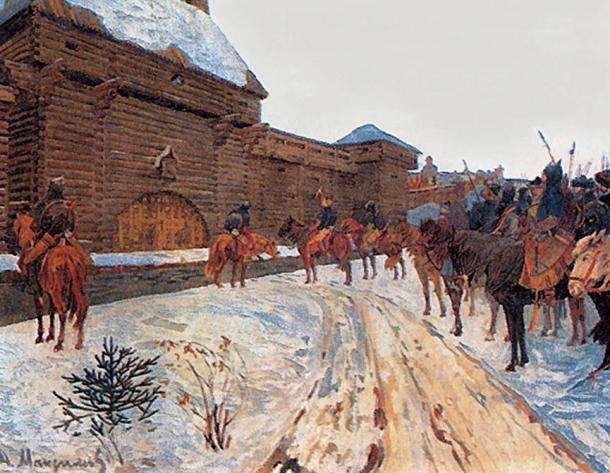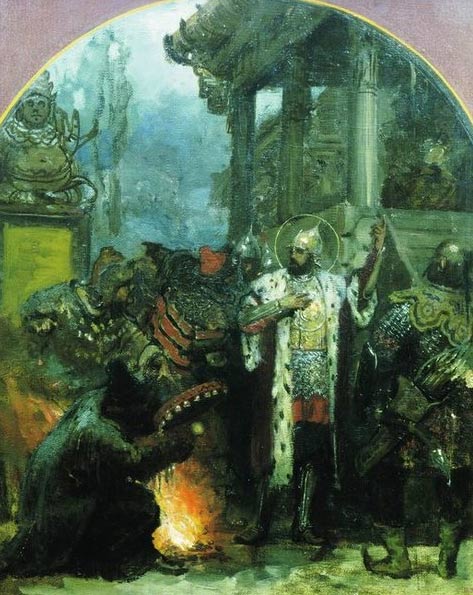
The Tatars: The Golden Horde, People from Hell, Or Something Else?
Today, Tatars is a collective name given to a number of Turkic-speaking groups that live in Russia and several former Soviet countries. But Tatars has had various other meanings through history. For instance, the Chinese referred to all of their northern neighbors as the barbaric ‘Ta-Ta’ or ‘Da-Da’, and during the 14th century Westerners used the same term to refer to the population of the Mongol Empire and the khanates that succeeded it.
Tatars in History
The name Tatar is said to have first appeared around the beginning of the 5th century AD amongst the nomadic Turkic peoples of northeastern Mongolia in the region of Lake Baikal. The Chinese term, ‘Ta-Ta’, is said to mean ‘dirty’ or ‘barbarian’.
Whilst the Tatars were already in contact with the Chinese during the early part of their history, their encounters with Europeans came much later on. During the early part of the 13th century, Genghis Khan united the various nomadic tribes of the Mongolian steppes and set out to conquer the world. Batu Khan, one of Genghis Khan’s grandsons, led the Mongol invasion of Eastern Europe.
- Thunder Clap and Lightning Strike! Conquering the World, and the Battle of Ankara – Part 1
- The Cossack Sorcerers of Folk Legends and Historical Chronicles
- A Forgotten Empire: The Ancient Kingdom of Mitanni
Under Batu’s leadership, the Golden Horde (as the invading Mongols became known) swept through European Russia, reaching Hungary and Germany in 1241. The Europeans distorted the name Tatar into Tartar, meaning ‘People from Hell’, which may be a reference to Tartarus, the ancient Greek version of Hell.

‘Mongols at the Walls of Vladimir’ by Vasily Maksimov. (Public Domain)
Tatar Religion and Administration
In spite of this name, the Tatars were far from being uncivilized barbarians. For instance, they had a sophisticated administrative system that allowed them to rule their lands effectively. The conquered lands were divided into districts and local administration was established so as to ensure obedience of the local population and the payment of tribute.
Although the invading Tatars were shamanists, they were tolerant of other religions. For example, they allowed an Orthodox bishopric to be established in Sarai, the capital of the Golden Horde, in 1261, whilst the clergy of the Kyivan Rus were exempted from paying taxes.

‘Genrikh Semiradsky’s ‘Alexander Nevsky in the Horde’. 1876. (Public Domain) Depicting Alexander Nevsky and a Mongol shaman.
The Tatar Economy
Due to their nomadic roots, herding was an important economic activity for the Tatars. Nevertheless, they also adopted mixed farming. Both of these continue to be important economic activities for the Tatars today. Additionally, the Tatars developed their skills as artisans and craftsmen in such areas as ceramics, woodwork, and metalwork. Moreover, the Tatars engaged in trade, with their main trading partners being the Italian colonies along the shores of the Black Sea and Egypt.
The Golden Horde Turns into Khanates
By the 14th century, the Golden Horde began to decline, and a century later, disintegrated into four independent khanates – Kazan, Astrakhan, Sibir, and Crimea. During the 16th century, the khanates of Kazan, Astrakhan, and Sibir were conquered by the Russians, whilst the Crimean Khanate became a vassal of the Ottoman Empire, though it too was annexed by Russia (in 1783).

Cossacks fighting Tatars from the Crimean Khanate (1890) by Józef, Brandt. (Public Domain)
Tatar Traditions
The Tatars, though part of the Russian Empire, maintained their own traditions, which may still be seen today. For instance, the Tatars eventually adopted Islam, and are still adherents of this religion. Nevertheless, the Tatars have co-existed peacefully with their Russian neighbors. This may be seen, for example, in Tatarstan.
- From Temujin to Genghis Khan: Hard Life Leads to Path of Vengeance – Part I
- Monumental Mongolian Burial Discovered Includes 14 Giant Inscribed Pillars
- Russian Atlantis: Tomb Raider’s Invisible City of Kitezh was a REAL Place
This area was home to the Volga-Bulgars, who were incorporated into the Golden Horde after they were conquered. After the disintegration of the Golden Horde, the area became the Kazan Khanate. By that time, the invaders had converted to Islam. In the historical city of Kazan, today the capital of Tatarstan (one of the internal republics of modern day Russia), one can see both Christian and Muslim places of worship.
Today, it is estimated that there are 6.6 million Tatars in Russia, the third largest ethnic group in the country. The Tatars also have a significant presence in Central Asian countries such as Kazakhstan, Tajikistan, and Turkmenistan. Furthermore, as a result of diaspora, Tatar communities are also found in North America, Germany, and Turkey.

A Tatar family portrait from the 16th century. (Public Domain)
Top image: ‘Taniec tatarski’ (Tatar's Dance), a painting by Juliusz Kossak. Source: Public Domain
By Ḏḥwty
References
Hays, J., 2013. Tatars. Available at: http://factsanddetails.com/russia/Minorities/sub9_3c/entry-5100.html
New World Encyclopedia, 2015. Tatars. Available at: http://www.newworldencyclopedia.org/entry/Tatars
The Editors of Encyclopaedia Britannica, 2014. Tatar. Available at: https://www.britannica.com/topic/Tatar
www.encyclopedia.com, 2016. Tatars. Available at: https://www.encyclopedia.com/social-sciences-and-law/anthropology-and-archaeology/people/tatars
Zakiev, M., 2002. Origins of Tatars. Available at: https://www.podgorski.com/main/tatar-origins.html
Zhdan, M. & Zhukovsky, A., 1993. Tatars. Available at: http://www.encyclopediaofukraine.com/display.asp?linkpath=pages%5CT%5CA%5CTatars.htm














